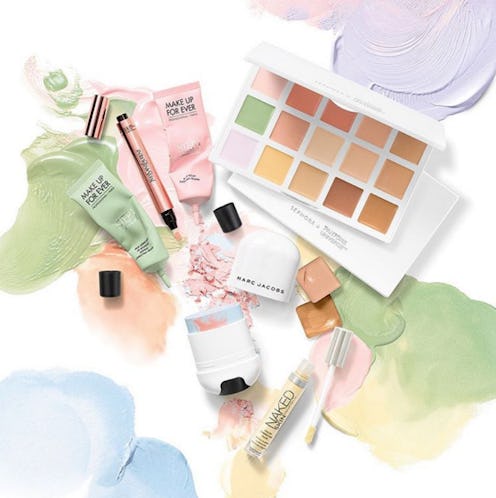Fashion
How To Find The Best Color Corrector For Your Skin

Hunting down the perfect shade of lipstick or a flawlessly matched foundation already puts you in a front row seat on the struggle bus. Throw trying to find the best color corrector into the mix, and it's enough to make you want to quit makeup altogether. You're probably surrounded by a sea of green, purple, and orange concealers every time you browse a makeup aisle. Chances are you're still stuck on whether you should even bother dabbling in the art of correcting and concealing.
Truth be told, we all experience discoloration from time to time. Maybe it's that pesky childhood acne that followed you into adulthood or a late night rager that gave you the-morning-after raccoon eyes. That's where correctors come into play to save the day. "Color correction is like a filter for your skin," Sephora PRO Eliza Devila tells me over email. "It allows you to eliminate any concerns and discoloration, resulting in less foundation and concealer application."
The trick to getting this technique is choosing the right color corrector. It's all about tackling basic color theory and determining what kind of formula will work in conjunction with your other skin concerns. During your quest to find the right corrector for you, I'm sure a few questions have crossed your mind. Here are the answers you crave!
1. Determine The Color You Need
Finally, all that time spent on the color wheel in your first grade art class is going to pay off. Basic color theory tells us that complementary colors — any two colors that appear as direct opposites on the color wheel — cancel each other out. The same theory applies to color correcting with makeup. For example, green is the opposite of red, so When you need to conceal rosacea or a red zit, green corrector is your best friend. Simple as that!
Sephora Collection Bright Future Color Corrector in Green, $14, Sephora
Yellow correctors work best on light complexions to conceal blueish-purple skin issues like bruises, dark under-eye circles, and exposed veins.
Urban Decay Naked Skin Color Correcting Fluid in Yellow, $28, Sephora
Purple, the opposite of yellow, will give dull skin a boost. A rich lavender is just what you need to brighten sallow skin that appears to be yellowing.
NYX Cosmetics Hi Definition Photo Concealer Wand in Lavender, $4, Amazon
If you're suffering from intensely dark under-eye circles, a peach or salmon corrector will work wonders for light to medium skin tones. These concealers combat the blue and purple undertones present within dark circles.
BECCA Backlight Targeted Colour Corrector in Peach, $30, Sephora
For darker skin tones, orange correctors are your go-to products to counteract deep, blueish under-eye circles. Dark spots, acne scarring, and sun spots also won't stand a chance against orange — the opposite of blue on the color wheel.
Make Up For Ever Step 1 Skin Equalizer Primer in Caramel, $37, Sephora
2. Find Your Perfect Formula
Just when you think you've got correcting all figured out, you get caught up trying to decide between a correcting stick, a liquid, and a powder. The formula of corrector you choose matters just as much as finding the right color. You want to think about the texture of the area where you're going to be applying product. When correcting your under eye, Devila recommends going with a cream or gel formula. "These blend easily and are great for layering with concealer and powder," she says. Liquid-based formulas may also work well with trouble areas on the rest of your face. "Powders tend to sit atop the skin and can look chalky. Sticks could possibly remove other makeup or primers," Urban Decay Founding Partner and Chief Creative Officer Wende Zomnir tells me via email.
3. Try A 2-in-1 Primer
"Primers are a two-in-one multitasking dream and a must for your makeup routine," says Devila. "Even if someone isn’t in need of extreme color correction, they can achieve flawless makeup results without a lot of product." A great color correcting primer, like the Smashbox Photo Finish Color Correction Foundation Primers that come in a variety of shades, can work wonders to minimize all-over discoloration like redness or dullness. "Most women, however, have a couple of color-correcting skin challenges, and may need to approach different areas of the face with a customized corrector," said Zomnir. In other words, color correction can work just as well on a spot-by-spot basis. In this case, a color correction palette may suit your fancy instead of a general, all-over primer. Having multiple correctors all in one compact will allow you to apply whatever color you need to different problem areas.
It may be intimidating as a makeup newbie to see a rainbow of concealers now that color correcting is more popular than ever. However, now that you've been refreshed on the color wheel, join in on this beauty craze and filter your discoloration away.
Images: Sephora/Instagram; Courtesy of Brands